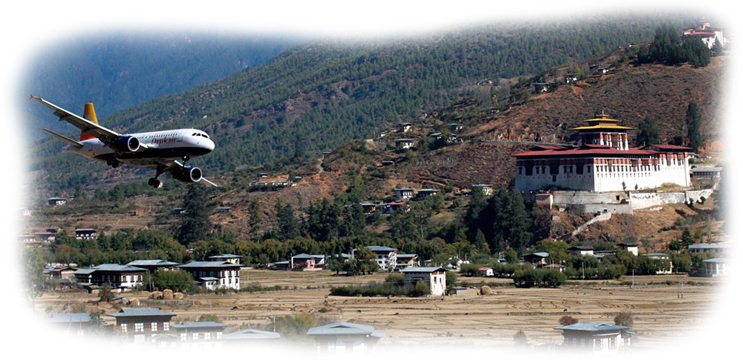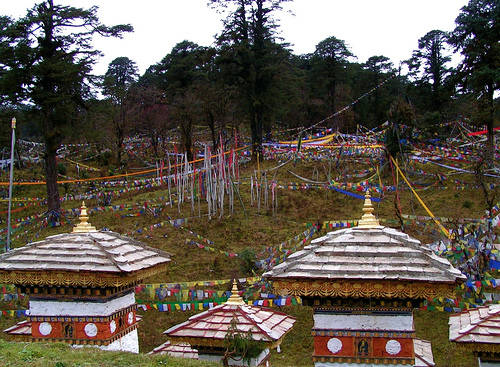
[ Druk Path Trek | Punakha Winter Trek | Gangtey Trek | Nabji-Korphu Community-based Nature Tourism Trek | Samtengang Winter Trek | Gasa Hot Springs Trek | Jhomolhari Trek I (Snow Leopard Trek) | Jhomolhari Trek II | Laya Gasa Trek | Snowman Trek I (to Sephu) | Snowman Trek II (to Bumthang) | Wild East Rodungla Trek | Dagala Thousand Lakes Trek ]
Gangtey Trek
- 10 Nights 11 Days
- Western Bhutan
Duration: 10 Nights
11 Days (Trek- 3 days)
High Season- March, April, May, September, October
& November
Low Season- January, February, June, July,
August & December
| Jan | Feb | Mar | Apr | May | Jun | July | Aug | Sept | Oct | Nov | Dec |
* Prices (costs) quoted are for the entire holiday from start to end.
Max. Elevation:
3,480 m
Highest Camp: 3,330 m
Standard: Easy
Best Seasons: September to May
Start: Phobjikha (Wangdue Dzongkhag)
Finish: Tikke Zampa (Wangdue Dzongkhag)
Gangtey (Wangdue) Trek Summary:
Itinerary Outline :
Day 01: Arrive Paro & Sightseeing.
Day 02: Paro Sightseeing
Day 03: Paro - Thimphu: Thimphu sightseeing
Day 04: Thimphu - Punakha
Day 05: Phobjikha - Zasa (Trek Starts)
Day 06: Zasa - Chorten Karpo
Day 07: Chorten Karpo - Tikke Zampa (Trek Ends)
Day 08: Wangduephodrang – Thimphu
Day 09: Thimphu – Paro via Haa Valley
Day 10: Haa to Paro valley
Day 11: Departure from Paro
Detailed Itinerary:

Day 1: Arrive Paro & Sightseeing.
Arrive at Paro Internationl Airport where you will be greeted by our representative and checked into your hotel. Today's programme will let you visit Tag (pronounced 'Taa') Dzong, built in the 17th century as a watch tower for Paro Rinpung Dzong (picture above right with Druk Air landing). This Dzong was later converted into the National Museum in 1967, and is filled with antique thangkha paintings, textiles, weapons and armour. Also visit the Rinpung Dzong, built in the 17th century to defend the valley against Tibetan invaders. It is now used as an administrative centre and home of the monastic community here. Kyichu Lhakhang, the oldest monastery of the Kingdom is another place of interest. Stroll around Paro town. Overnight in Hotel.
Day 2: Paro Sightseeing
Hike to the famous Taktsang Lhakhang, the 'Tiger's Lair' or 'Nest'. Clinging to a black rock face 900 metres above the valley floor nestles Taktsang Lhakhang, one of the holiest and most beautiful sites of Bhutan. Taktsang, the Tiger's Lair, acquires its name from the legend of its foundation when in the 8th Century Guru Rinpoche (Guru Padmasambhava), widely revered as the second Buddha, arrived from Tibet flying across the mountains on the back of a Tigress. He meditated at the site for three months from where he used the religious cycle of the Kagye to subjugate the Eight Categories of Evil Spirits, and thus converted the region to Buddhism. The hike to the Monastery is a gradual climb through the quiet approach path which winds through lush meadows, oak and rhododendron forests, past quaint hamlets, fluttering prayer flags and rotating prayer wheels. The hike takes you about 4-5 hours from the car park. Afternoon leisure/shopping. Overnight in Hotel.
Day 3: Paro - Thimphu: Thimphu sightseeing
In the morning drive to Thimphu. Full day sightseeing in Thimphu. At the heart of Thimphu visit the Third King's Memorial Chorten (Stupa) built in 1974 where you will find many devotees circumambulating the Chorten. You will also visit the Changangkha Lhakhang ('Lhakhang' means Temple) in Thimphu. One interesting belief that the Bhutanese take seriously since it works all the time is when infants born in Thimphu do not sleep at night they are brought here after which they sleep well! Also visit the Jungshi Paper factory where they make traditional Bhutanese paper, the National Library that houses the world’s largest book, ancient Buddhist texts and manuscripts, a Painting School famous for traditional thangkhas ('thangkha' is a religious painting). We will also visit the Folk Heritage Museum founded by Her Majesty the Queen Mother, Ashi Dorji Wangmo Wangchuck. The museum is one of a kind that portrays the lifestyle of a genteel family in Thimphu valley in the olden days. Visit the Choki Handicrafts shop where Bhutanese textiles and other handicrafts are displayed and can be purchased. The shop is closely linked to the Choki Traditional Art School- many of the goods are produced in the school itself and all proceeds go towards the upkeep of the school and the provision of tuition for the students. Later, visit the Tashichhodzong- The ‘Fortress of the Glorious Religion’ houses the throne room of His Majesty the King, the Main Secretariat Building and the Central Monk Body. Its courtyard is open to visitors during the off-office hours- on weekends and weekdays after 4 pm (winter) and 5 pm (summer). Overnight at Hotel.
Day 4: Thimphu - Punakha
 Head
out of town on a spectacular 3 hours drive to Punakha crossing the Dochula
Pass at 3100 metres from where you can see the 108 beautiful Chortens
(left) built by Her Majesty the Queen Mother, Ashi Dorji Wangmo
Wangchuck. From this pass, on a clear day you can have a superb view of
the highest peaks in Bhutan. After a hot lunch at the cafe atop the pass
and time to savour the mountain views, we continue our drive to Punakha
Valley. Sightseeing in Punakha. Drive to Gangtey. Overnight in Camp.
Head
out of town on a spectacular 3 hours drive to Punakha crossing the Dochula
Pass at 3100 metres from where you can see the 108 beautiful Chortens
(left) built by Her Majesty the Queen Mother, Ashi Dorji Wangmo
Wangchuck. From this pass, on a clear day you can have a superb view of
the highest peaks in Bhutan. After a hot lunch at the cafe atop the pass
and time to savour the mountain views, we continue our drive to Punakha
Valley. Sightseeing in Punakha. Drive to Gangtey. Overnight in Camp.
Day 5: Phobjikha - Zasa (Trek
Starts)
(Distance 15 km, six to seven hours, 610 m ascent, 410 m descent,
camp altitude 3,130 m)
The Trek starts near the village of Tabiting. The trail winds through
meadows and fields and the climb takes you through a mixed forest of juniper,
bamboo, magnolia and rhododendron to Chele La Pass (3430 m). From here
you descend into the Juge Kangkha Chhu valley. Further on, the path leads
to Gogona, well known for its Gogona Cheese production. The campsite is
a bit further on besides a small stream in a yak pasture called Zasa.
Day 6: Zasa - Chorten Karpo
(Distance 16 km, five to seven hours,
450 m ascent, 860 m descent, camp altitude 3,330 m)
A gentle climb leads to Shobe La pass (3,480 m). The descent from the
pass leads to a wide valley, surrounded by beautiful mountain ranges.
Below the route one can see Khothokha, a village with about 60 houses.
You finally reach the campsite by climbing gently up till you see four
Chortens in a forest of blue pine.
Day 7: Chorten Karpo - Tikke Zampa (Trek Ends)
(Distance 12 km, four to five hours,
120 m ascent, 1,340 m descent)
From the camp you climb till you reach a forest road. From here it’s
an easy walk up to a little ridge at 2,800 m. The walkdown back into the
valley leads you through Bhutan’s best bird watching areas. Night
at hotel in Wangdue.
Day 8: Wangduephodrang – Thimphu
Visit the remains of the beautiful Wangduephodrang Dzong built in 1638, a once beautiful example of Bhutanese architecture. Sadly, the Dzong was razed by fire in 2012 and funds to renovate have been raised from both Bhutanese and visitors. On the way to Dochula, a stop and a half-hour walk through mustard fields brings us to Chimi Lhakhang, a Monastery and Fertility Temple dedicated to Lama Drukpa Kuenley, a Tibetan Buddhist Saint known popularly as ‘the Divine Madman’ and considered a folk hero in Bhutan for his unconventional ways. Drukpa Kuenley originally built a Chorten on the site in the 14th century. The temple, flanked by nearly 100 tall prayer flags, sits atop a picturesque hill and has long been a pilgrimage site for childless couples. Tales of people from all over the world blessed with children after a visit here abounds. Overnight at Thimphu Hotel.
Day 9: Thimphu – Paro via Haa Valley
Morning drive from Thimphu to Haa valley.
About Haa Valley: Haa Valley is set at an altitude of about 9,000
feet in Western Bhutan. Haa valley opened to outsiders only in 2002. The
Haa region is pristine and holds a wealth of traditional culture. For
many centuries it was the centre of trade between Western Bhutan and the
Chumbi Valley of Tibet. The mountain-ringed valley is dotted with fields
of millet, barley, potatoes, and wheat. Its farmhouses are beautiful and
richly adorned with traditional painted motifs. Three prominent hills
dot the valley and are believed by the locals to be the physical manifestations
of three very important Buddhist saints. The left-hand hill represents
Manjushri (the God of Wisdom who holds the flaming sword that cuts the
knot of ignorance), the middle one is Chenrizig (the Buddha of Compassion,
of which the Dalai Lama is the human incarnation), and the right-hand
hill is Chana Dorji (the Protector God of Bhutan). Collectively they are
known as Rigsum (three hills).
After lunch at our lodge, we visit Lhakhang Karpo, the “Temple of the White Dove”, a Monastery believed to have been built in the 8th century by the Tibetan King, Songtsen Gampo, after he sent two doves (one black and one white) to find a sacred place to build a monastery. Another legend tells how the local nomads erected the temples in a single day- hence the name of the valley, Haa, meaning ‘sudden’. The Lhakhang Karpo houses around 120 monks and is one of the oldest buildings in Bhutan. Visit the Haa dzong situated in the centre of the valley. Overnight at Lodge in Haa.
Day 10: Haa to Paro valley
The 2 hours winding road from Haa to Paro ascends through pastureland past grazing yaks before reaching the 3,900 metres Chelela Pass (left) one of the Highest Road Passes in Bhutan. Four kilometres below the pass towards Paro valley at a turn-off is a herders’ camp marked by prayer flags. From here hiking trails lead up for 45 minutes to Kila Goemba, a nunnery, established as a meditation site in the 9th century and reputedly the oldest nunnery in Bhutan. The hike to the nunnery is truly rewarding with a superb view of the Himalayan Mountains and Paro valley. Driving down into Paro Valley, the scenery transforms from sub-alpine pasture brilliant with wildflowers, to lush forests of blue pine, cypress, larch, fir and rhododendron. Stroll around Paro town for shopping. Traditional Bhutanese dinner and overnight at Hotel in Paro.
Day 11: Departure from Paro
It's off to the airport and we have to bid you Goodbye hoping to see you again one day...
Note: These trekking itineraries have been designed based on past experiences of visitors to Bhutan and what they experienced about various trek routes. They show the actual duration of the trek only. They can be combined with other cultural tours or treks. The treks are such that you can gain the maximum out of this experience without exhausting you. The treks may depend on seasons. However, these readymade itineraries may not be convenient for some visitors. That is why we would be very happy to, together with you, design a new itinerary to fit all criteria and interests as desired by you. Please write to us with your special interests and/or requirements at bhutanrebirth@gmail.com.
| |
BACK TO TREKS MAIN PAGE |
